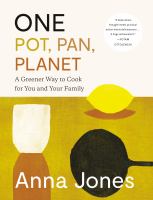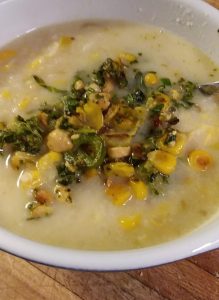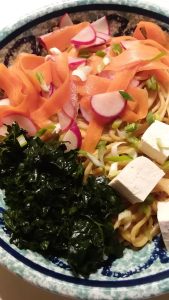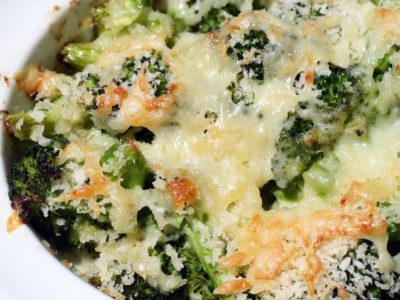
Bibliobites in April: One Pot, One Pan, One Book
 Sustainability: it’s a word and an idea that’s on everyone’s radar. But it’s such an all-encompassing concept that often it’s hard to figure out how we can and should apply it to different aspects of our lives. In the supermarket and in the kitchen, then, what does sustainable mean, and how would we incorporate such an approach into our cooking? This month’s title, One Pot, Pan, Planet by Anna Jones (our tie-in with this year’s One Book, Migrations by Charlotte McConaghy), provides a template for using less energy and fewer resources in our daily cooking. Less waste is certainly a desirable goal, but tasty meals are also important– so did we discover that you can have both?
Sustainability: it’s a word and an idea that’s on everyone’s radar. But it’s such an all-encompassing concept that often it’s hard to figure out how we can and should apply it to different aspects of our lives. In the supermarket and in the kitchen, then, what does sustainable mean, and how would we incorporate such an approach into our cooking? This month’s title, One Pot, Pan, Planet by Anna Jones (our tie-in with this year’s One Book, Migrations by Charlotte McConaghy), provides a template for using less energy and fewer resources in our daily cooking. Less waste is certainly a desirable goal, but tasty meals are also important– so did we discover that you can have both?
Unsurprisingly, this book contains only vegetarian recipes. Eating lower on the food chain reduces environmental impact, and costs less, too; no small consideration given the sharp increase in food prices over the last year. Most in our group are happy to discover new ways with beans, grains, or veggies, and the “one pot” concept always appeals! In fact, this book is arranged by cooking vessel (more on that later), whether pot, skillet, or sheet pan. The majority of recipes are either main dishes or close to that, needing only perhaps rice or bread to make a complete meal. Sturdy, reliable cauliflower had a star turn in many recipes: pan-roasted cauliflower with saffron butter was a huge hit with its herby yogurt sauce. Cooking the cauliflower in a cast iron pan gave it plenty of crispy brown bits, a perfect contrast to the silky sauce. Sticky sesame-baked cauliflower also had a super sauce, this one an addictive blend of salty soy sauce and sweet maple syrup. Chili paste added a nice kick. Two people made  corn and cauliflower chowder, but for both it was a big disappointment. There was an excessive amount of corn in the chowder; its flavor and texture dominated unpleasantly. The saving grace was a zippy topper of sauteed peanuts, scallions, and chilis. Cauliflower was also played a strong supporting role in saag aloo shepherd’s pie. This well-spiced casserole of beans and tomatoes used mashed potatoes and cauliflower for a topper. Though this dish was “very good” and “looked just like the photo,” it was a bit of a project, even though it was in the “Quick” chapter.
corn and cauliflower chowder, but for both it was a big disappointment. There was an excessive amount of corn in the chowder; its flavor and texture dominated unpleasantly. The saving grace was a zippy topper of sauteed peanuts, scallions, and chilis. Cauliflower was also played a strong supporting role in saag aloo shepherd’s pie. This well-spiced casserole of beans and tomatoes used mashed potatoes and cauliflower for a topper. Though this dish was “very good” and “looked just like the photo,” it was a bit of a project, even though it was in the “Quick” chapter.
Stalwarts cabbage and carrots were also frequently featured: three people tried carrot and sesame pancakes (interestingly, these were really mostly cabbage!). These crispy fritters highlighted the classic soy/ginger combination, and were loaded with shredded veggies. Though the flavor and texture were excellent when first made, leftovers were a bust. No matter how they were reheated, they were on the dry side, and the cabbage became unpleasantly chewy. But, “I would try again, with wilted or sauteed (as opposed to raw) cabbage.” Roasted rainbow carrots with beans and salsa rustica made a fine main dish with the addition of some cooked farro; but the salsa, though quite good, required much chopping, “I liked this but it wasn’t worth the time.” Carrot and peanut nasi goreng was a pleasing bowl of fried rice, also featuring cabbage and tofu. Two people made this and thought it was a solid version of fried rice. The garnishes of cilantro, lime, and fried shallots definitely kicked it up a notch.
Tofu made several appearances in this book; though it had “a lot of ingredients,” flash-fried sticky tofu was “good!” with an appropriately sticky glaze.  White miso ramen was a soupy bowl of goodness with its umami-loaded, creamy noodles paired with cooling tofu and crisp veggies. A keeper! We tried a few bean-centered casseroles: quick chickpea braise with kale and harissa was, in fact, quick; it was “very tasty….and a good leftover.” Baked dhal with tamarind-glazed sweet potatoes was “nice and creamy,” since the lentils were cooked in plant-based milk. The caramelized sweet potato topping added flavor and texture. On the negative side, lemon chickpea and green herb stew was “bland” and “lacked oomph;” despite a full can of coconut milk, our cook “couldn’t taste the coconut.” And quick squash lasagna was “relatively quick;” our cook liked the lentils in it though the dish as a whole had “too much squash.” Still, “I might make again!”
White miso ramen was a soupy bowl of goodness with its umami-loaded, creamy noodles paired with cooling tofu and crisp veggies. A keeper! We tried a few bean-centered casseroles: quick chickpea braise with kale and harissa was, in fact, quick; it was “very tasty….and a good leftover.” Baked dhal with tamarind-glazed sweet potatoes was “nice and creamy,” since the lentils were cooked in plant-based milk. The caramelized sweet potato topping added flavor and texture. On the negative side, lemon chickpea and green herb stew was “bland” and “lacked oomph;” despite a full can of coconut milk, our cook “couldn’t taste the coconut.” And quick squash lasagna was “relatively quick;” our cook liked the lentils in it though the dish as a whole had “too much squash.” Still, “I might make again!”
One aspect of this book that we all enjoyed was the “ten simple [name of veggie] ideas.” These two-page spreads provided quick and easy recipes for a vegetable you might have languishing in your crisper. Cheesy  quick broccoli gratin was a hit from this section; it was delicious when first made and was a “really good leftover.” However, broccoli and sesame noodles did not make the grade; the “thin, bitter” sauce was “awful.” In looking at the recipe, the group thought perhaps the amount of vinegar called for overpowered the other flavors. Frittatas also came in for the simple, check-what’s-in-the-fridge treatment; our cook tried a combination of asparagus, cheese, and onion that was tasty enough. But, “it was better when I added some salami!” Despite the fact that salami is obviously not a vegetarian ingredient, it still fits into the premise of the book: use up what you have and don’t waste anything.
quick broccoli gratin was a hit from this section; it was delicious when first made and was a “really good leftover.” However, broccoli and sesame noodles did not make the grade; the “thin, bitter” sauce was “awful.” In looking at the recipe, the group thought perhaps the amount of vinegar called for overpowered the other flavors. Frittatas also came in for the simple, check-what’s-in-the-fridge treatment; our cook tried a combination of asparagus, cheese, and onion that was tasty enough. But, “it was better when I added some salami!” Despite the fact that salami is obviously not a vegetarian ingredient, it still fits into the premise of the book: use up what you have and don’t waste anything.
 There are only a few dessert recipes in this book, and though many of us had intentions to try something, only one person followed through with chocolate and almond butter swirl brownies. These were a rich and deeply chocolate riff on the classic chocolate/peanut butter combo. They were a bit crumbly, but no one who sampled these at our meeting had any complaints!
There are only a few dessert recipes in this book, and though many of us had intentions to try something, only one person followed through with chocolate and almond butter swirl brownies. These were a rich and deeply chocolate riff on the classic chocolate/peanut butter combo. They were a bit crumbly, but no one who sampled these at our meeting had any complaints!
This was an interesting title for most of us, for several reasons. First, the organization of the book (by cooking vessel) was either helpful or annoying, depending on how you’re approaching things at any given moment. Also, fairly often the “one pot” concept was a bit inaccurate. Maybe technically there was one pot or pan, but multiple bowls were needed to prep and organize. Or you had to cook one ingredient, remove it from the pan to a bowl or plate, then wipe out the pan to re-use. That doesn’t seem to be quite in the spirit of one-pot cooking! Also, despite the “sustainable” moniker, the author frequently uses expensive or less-available ingredients; perhaps all that cabbage just needs a little flavor boost? There are a lot of nuts and seeds in the recipes, which some can’t eat, and they are pricey. Other ingredients that were used a bit too often were soy sauce, chili oil, miso, and kale. All of these are delicious, but they did seem to make a few too many appearances.
The book itself and its photos also came in for discussion and criticism. Many were puzzled by and unimpressed with the extremely neutral color palette of the photos, as well as their spare design. It’s a definite look that might or might not appeal. The text is very small, with ingredient lists in the pale gray font which has become very common, and can be difficult to read, especially in combination with tiny text. There’s quite a lot of general and detailed information on more-sustainable food purchasing and cooking practices, which gave us some new ideas to digest, pun intended!
While we can certainly get on board with the author’s premise of shopping and cooking more mindfully, for most, strictly as a cookbook, this title just didn’t appeal and our rating reflects that: our votes averaged out to a 2.3 (out of a possible 5). That’s our lowest score in some time. Please join us for our next meeting on Friday, May 26 at 11 AM in the Fireplace Room, when we’ll be discussing Jew-ish: reinvented recipes from a modern mensch by Jake Cohen. If you think Jewish cuisine is only latkes and matzoh ball soup, you’re in for a surprise. For instance, try the tart, salty, spicy pomegranate-bbq chicken wings on page 61. Positively addictive! Copies are available at the main circulation desk or via curbside pickup.






